Development of a Dust Source Map for WRF-Chem Model Based on MODIS NDVI
Abstract
:1. Introduction
2. Experimental Design
2.1. NDVI Datasets
2.2. The WRF-Chem Model
2.3. AERONET Data and Evaluation Metrics
3. Results
4. Summary and Conclusions
Author Contributions
Funding
Institutional Review Board Statement
Informed Consent Statement
Data Availability Statement
Acknowledgments
Conflicts of Interest
References
- Myhre, G.; Shindell, D.; Bréon, F.-M.; Collins, W.; Fuglestvedt, J.; Huang, J.; Koch, D.; Lamarque, J.-F.; Lee, D.; Mendoza, B.; et al. Anthropogenic and Natural Radiative Forcing. In Climate Change 2013: The Physical Science Basis. Contribution of Working Group I to the Fifth Assessment Report of the Intergovernmental Panel on Climate Change; Stocker, T.F., Qin, D., Plattner, G.-K., Tignor, M., Allen, S.K., Boschung, J., Nauels, A., Xia, Y., Bex, V., Midgley, P.M., Eds.; Cambridge University Press: Cambridge, UK; New York, NY, USA, 2013. [Google Scholar]
- Gassó, S.; Grassian, V.H.; Miller, R.L. Interactions between Mineral Dust, Climate, and Ocean Ecosystems. Elements 2010, 6, 247–252. [Google Scholar] [CrossRef]
- Spyrou, C.; Kallos, G.; Mitsakou, C.; Athanasiadis, P.; Kalogeri, C.; Iacono, M.J. Modeling the radiative effects of desert dust on weather and regional climate. Atmos. Chem. Phys. 2013, 13, 5489–5504. [Google Scholar] [CrossRef] [Green Version]
- Mahowald, N.M.; Albani, S.; Kok, J.F.; Engelstaedter, S.; Scanza, R.; Ward, D.S.; Flanner, M.G. The size distribution of desert dust aerosols and its impact on the Earth system. Aeol. Res. 2014, 15, 53–71. [Google Scholar] [CrossRef] [Green Version]
- Kumar, P.; Sokolik, I.N.; Nenes, A. Measurements of cloud condensation nuclei activity and droplet activation kinetics of fresh unprocessed regional dust samples and minerals. Atmos. Chem. Phys. 2011, 11, 3527–3541. [Google Scholar] [CrossRef] [Green Version]
- Solomos, S.; Kallos, G.; Kushta, J.; Astitha, M.; Tremback, C.; Nenes, A.; Levin, Z. An integrated modeling study on the effects of mineral dust and sea salt particles on clouds and precipitation. Atmos. Chem. Phys. 2011, 11, 873–892. [Google Scholar] [CrossRef] [Green Version]
- Creamean, J.M.; Suski, K.J.; Rosenfeld, D.; Cazorla, A.; DeMott, P.J.; Sullivan, R.C.; White, A.B.; Ralph, F.M.; Minnis, P.; Comstock, J.M.; et al. Dust and biological aerosols from the Sahara and Asia influence precipitation in the western U.S. Science 2013, 339, 1572–1578. [Google Scholar] [CrossRef] [Green Version]
- Spyrou, C. Direct radiative impacts of desert dust on atmospheric water content. Aerosol Sci. Technol. 2018, 52, 693–701. [Google Scholar] [CrossRef]
- Duce, R.A.; Liss, P.S.; Merrill, J.T.; Atlas, E.L.; Buat-Menard, P.; Hicks, B.B.; Miller, J.M.; Prospero, J.M.; Arimoto, R.; Church, T.M.; et al. The Atmospheric Input of Trace Species to the World Ocean. Glob. Biogeochem. Cycles 1991, 5, 193–259. [Google Scholar] [CrossRef]
- Jickells, T.D.; An, Z.S.; Andersen, K.K.; Baker, A.R.; Bergametti, G.; Brooks, N.; Cao, J.J.; Boyd, P.W.; Duce, R.A.; Hunter, K.A.; et al. Global Iron Connections between Desert Dust, Ocean Biogeochemistry, and Climate. Science 2005, 308, 67–71. [Google Scholar] [CrossRef] [Green Version]
- Goudie, S.A. Desert Dust and Human Health Disorders. Environ. Int. 2013, 63, 101–113. [Google Scholar] [CrossRef]
- Esmaeil, N.; Gharagozloo, M.; Rezaei, A.; Grunig, G. Dust events, pulmonary diseases and immune system. Am. J. Clin. Exp. Immunol. 2014, 3, 20–29. [Google Scholar] [PubMed]
- Guieu, C.; Shevchenko, V.P. Dust in the Ocean. In Encyclopedia of Marine Geosciences; Springer: Dordrecht, The Netherlands, 2015. [Google Scholar] [CrossRef]
- Scanza, R.A.; Mahowald, N.; Ghan, S.; Zender, C.S.; Kok, J.F.; Liu, X.; Zhang, Y.; Albani, S. Modeling dust as component minerals in the Community Atmosphere Model: Development of framework and impact on radiative forcing. Atmos. Chem. Phys. 2015, 15, 537–561. [Google Scholar] [CrossRef] [Green Version]
- Intergovernmental Panel on Climate Change (IPCC); Ranasinghe, R.; Ruane, A.C.; Vautard, R.; Arnell, N.; Coppola, E.; Cruz, F.A.; Dessai, S.; Islam, A.S.; Rahimi, M.; et al. Climate Change Information for Regional Impact and for Risk Assessment. In Climate Change 2021: The Physical Science Basis. Contribution of Working Group I to the Sixth Assessment Report of the Intergovernmental Panel on Climate Change; Masson-Delmotte, V., Zhai, P., Pirani, A., Connors, S.L., Péan, C., Berger, S., Caud, N., Chen, Y., Goldfarb, L., Gomis, M.I., et al., Eds.; Cambridge University Press: Cambridge, UK; New York, NY, USA, 2021; pp. 1767–1926. [Google Scholar] [CrossRef]
- Prospero, J.M.; Ginoux, P.; Torres, O.; Nicholson, S.E.; Gill, T.E. Environmental Characterization of Global Sources of Atmospheric Soil Dust Identified with the Nimbus 7 Total Ozone Mapping Spectrometer (Toms) Absorbing Aerosol Product. Rev. Geophys. 2002, 40, 1002. [Google Scholar] [CrossRef]
- Tegen, I.; Harrison, S.; Kohfeld, K.; Prentice, I.C.; Coe, M.; Heimann, M. Impact of vegetation and preferential source areas on global dust aerosol: Results from a model study. J. Geophys. Res. 2002, 107, 4576. [Google Scholar] [CrossRef] [Green Version]
- Crouvi, O.; Schepanski, K.; Amit, R.; Gillespie, A.R.; Enzel, Y. Multiple dust sources in the Sahara Desert: The importance of sand dunes. Geophys. Res. Lett. 2012, 39, L13401. [Google Scholar] [CrossRef]
- Anderson, J.; Hardy, E.; Roach, J.; Witmer, R. A Land Use and Land Cover Classification System for Use with Remote Sensing Data, U.S. Geological Survey; USGS Professional Paper 964; United States Government Printing Office: Washington, DC, USA, 1976.
- Spyrou, C.; Mitsakou, C.; Kallos, G.; Louka, P.; Vlastou, G. An improved limited area model for describing the dust cycle in the atmosphere. J. Geophys. Res. 2010, 115, D17211. [Google Scholar] [CrossRef]
- Skamarock, W.C.; Klemp, J.B.; Dudhia, J.; Gill, D.O.; Liu, Z.; Berner, J.; Wang, W.; Powers, J.G.; Duda, M.G.; Barker, D.M.; et al. A Description of the Advanced Research WRF Version 4; NCAR Technical Note NCAR/TN-556+STR; NCAR: Boulder, CO, USA, 2019. [Google Scholar]
- Grell, G.A.; Peckham, S.E.; Schmitz, R.; McKeen, S.A.; Frost, G.; Skamarock, W.C.; Eder, B. Fully coupled ‘online’ chemistry in the WRF model. Atmos. Environ. 2005, 39, 6957–6976. [Google Scholar] [CrossRef]
- Schmechtig, C.; Marticorena, B.; Chatenet, B.; Bergametti, G.; Rajot, J.L.; Coman, A. Simulation of the Mineral Dust Content over Western Africa from the Event to the Annual Scale with the CHIMERE DUST Model. Atmos. Chem. Phys. 2011, 11, 7185–7207. [Google Scholar] [CrossRef] [Green Version]
- Menut, L.; Bessagnet, B.; Khvorostyanov, D.; Beekmann, M.; Blond, N.; Colette, A.; Coll, I.; Curci, G.; Foret, G.; Hodzic, A.; et al. CHIMERE 2013: A model for regional atmospheric composition modelling. Geosci. Model Dev. 2013, 6, 981–1028. [Google Scholar] [CrossRef] [Green Version]
- Escribano, J.; Boucher, O.; Chevallier, F.; Huneeus, N. Subregionalinversion of North Africandust sources. J. Geophys. Res. Atmos. 2016, 121, 8549–8566. [Google Scholar] [CrossRef] [Green Version]
- Walko, R.L.; Band, L.E.; Baron, J.; Kittel, T.G.F.; Lammers, R.; Lee, T.J.; Ojima, D.; Pielke, R.A., Sr.; Taylor, C.; Tague, C.; et al. Coupled atmosphere- biophysicshydrology models for environmental modeling. J. Appl. Meteorol. 2000, 39, 931–944. [Google Scholar] [CrossRef]
- Pausata, F.S.R.; Gaetani, M.; Messori, G.; Berg, A.; de Souza, D.M.; Sage, R.F.; DeMenocal, P.B. The Greening of the Sahara: Past Changes and Future Implications. One Earth 2020, 2, 235–250. [Google Scholar] [CrossRef]
- Feuerstein, S.; Schepanski, K. Identification of Dust Sources in a Saharan Dust Hot-Spot and Their Implementation in a Dust-Emission Model. Remote Sens. 2018, 11, 4. [Google Scholar] [CrossRef] [Green Version]
- Boloorani, A.D.; Kazemi, Y.; Sadeghi, A.; Shorabeh, S.N.; Argany, M. Identification of dust sources using long term satellite and climatic data: A case study of Tigris and Euphrates basin. Atmos. Environ. 2020, 224, 117299. [Google Scholar] [CrossRef]
- Rodell, M.; Houser, P.R.; Jambor, U.; Gottschalck, J.; Mitchell, K.; Meng, C.-J.; Arsenault, K.; Cosgrove, B.; Radakovich, J.; Bosilovich, M.; et al. The Global Land Data Assimilation System. Bull. Am. Meteorol. Soc. 2004, 85, 381–394. [Google Scholar] [CrossRef] [Green Version]
- Vukovic, A.; Vujadinovic, M.; Pejanovic, G.; Andric, J.; Kumjian, M.R.; Djurdjevic, V.; Dacic, M.; Prasad, A.K.; El-Askary, H.M.; Paris, B.C.; et al. Numerical simulation of “an American haboob”. Atmos. Chem. Phys. 2014, 14, 3211–3230. [Google Scholar] [CrossRef] [Green Version]
- Vukovic, A. Report on Consultancy to Develop Global Sand and Dust Source Base Map, No. CCD/18/ERPA/21; UNCCD: Belgrade, Serbia, 2019. [Google Scholar]
- Vukovic, A.; UNCCD. Sand and Dust Storms Source Base-Map. Visualization Tool. 2021. Available online: https://maps.unccd.int/sds/ and https://www.youtube.com/watch?v=4tsbspJvuAs (accessed on 26 April 2022).
- Bergametti, G.; Marticorena, B.; Rajot, J.L.; Siour, G.; Feron, A.; Gaimoz, C.; Coman, A.; Chatenet, B.; Coulibaly, M.; Maman, A.; et al. The Respective Roles of Wind Speed and Green Vegetation in Controlling Sahelian Dust Emission during the Wet Season. Geophys. Res. Lett. 2020, 47, e2020GL089761. [Google Scholar] [CrossRef]
- Solomos, S.; Ansmann, A.; Mamouri, R.-E.; Binietoglou, I.; Patlakas, P.; Marinou, E.; Amiridis, V. Remote sensing and modelling analysis of the extreme dust storm hitting the Middle East and eastern Mediterranean in September 2015. Atmos. Chem. Phys. 2017, 17, 4063–4079. [Google Scholar] [CrossRef] [Green Version]
- Solomos, S.; Abuelgasim, A.; Spyrou, C.; Binietoglou, I.; Nickovic, S. Development of a dynamic dust source map for NMME-DREAM v1.0 model based on MODIS Normalized Difference Vegetation Index (NDVI) over the Arabian Peninsula. Geosci. Model Dev. 2019, 12, 979–988. [Google Scholar] [CrossRef] [Green Version]
- Holben, B.N.; Eck, T.F.; Slutsker, I.; Tanré, D.; Buis, J.P.; Setzer, A.; Vermote, E.; Reagan, J.A.; Kaufman, Y.J.; Nakajima, T.; et al. AERONET—A Federated Instrument Network and Data Archive for Aerosol Characterization. Remote Sens. Environ. 1998, 66, 1–16. [Google Scholar] [CrossRef]
- Giles, D.; Sinyuk, M.; Sorokin, A.; Schafer, M.G.; Smirnov, J.S.; Slutsker, A.; Eck, I.; Holben, T.F.; Lewis, B.N.; Campbell, J.R.; et al. Advancements in the Aerosol Robotic Network (AERONET) Version 3 database—Automated near-real-time quality control algorithm with improved cloud screening for Sun photometer aerosol optical depth (AOD) measurements. Atmos. Meas. Technol. 2019, 12, 169–209. [Google Scholar] [CrossRef] [Green Version]
- Pettorelli, N.; Ryan, S.; Mueller, T.; Bunnefeld, N.; Jedrzejewska, B.; Lima, M.; Kausrud, K. The Normalized Difference Vegetation Index (NDVI): Unforeseen successes in animal ecology. Clim. Res. 2011, 46, 15–27. [Google Scholar] [CrossRef]
- Rouse, R., Jr.; Haas, H.; Schell, J.A.; Deering, D.W. Monitoring vegetation systems in the Great Plains with ERTS. In Goddard Space Flight Center 3D ERTS-1 Symp.; Sect. A; NASA: Washington, DC, USA, 1974; Volume 1, pp. 309–317. [Google Scholar]
- Huete, A.R.; Justice, C.; van Leeuwen, W. MODIS Vegetation Index (MOD 13): Algorithm Theoretical Basis Document; NASA Goddard Space Flight Center: Greenbelt, MD, USA, 1999.
- Solano, R.; Didan, K.; Jacobson, A.; Huete, A. MODIS Vegetation Index User’s Guide, Ver. 2.0, Vegetation Index and Phenology Lab; The University of Arizona: Tucson, AZ, USA, 2010; Available online: https://vip.arizona.edu (accessed on 26 April 2022).
- Didan, K. MOD13A2 MODIS/Terra Vegetation Indices 16-Day L3 Global 1 km SIN Grid V006 [Data Set]. NASA EOSDIS Land Processes DAAC. 2015. Available online: https://ladsweb.modaps.eosdis.nasa.gov/missions-and-measurements/products/MOD13A2 (accessed on 4 February 2022).
- Ginoux, P.; Chin, M.; Tegen, I.; Prospero, J.M.; Holben, B.; Dubovik, O.; Lin, S.-J.S. Sources and distributions of dust aerosols simulated with the GOCART model. J. Geophys. Res. 2001, 106, 20255–20273. [Google Scholar] [CrossRef]
- LeGrand, S.L.; Polashenski, C.; Letcher, T.W.; Creighton, G.A.; Peckham, S.E.; Cetola, J.D. The AFWA Dust Emission Scheme for the GOCART Aerosol Model in WRF-Chem v3.8.1; Cold Regions Research and Engineering Laboratory (U.S.): Hanover, NH, USA; Engineer Research and Development Center (U.S.): Vicksburg, MI, USA, 2019; Volume 12, pp. 131–166. [Google Scholar] [CrossRef] [Green Version]
- Solomos, S.; Kalivitis, N.; Mihalopoulos, N.; Amiridis, V.; Kouvarakis, G.; Gkikas, A.; Binietoglou, I.; Tsekeri, A.; Kazadzis, S.; Kottas, M.; et al. From Tropospheric Folding to Khamsin and Foehn Winds: How Atmospheric Dynamics Advanced a Record-Breaking Dust Episode in Crete. Atmosphere 2018, 9, 240. [Google Scholar] [CrossRef] [Green Version]
- National Centers for Environmental Prediction; National Weather Service; NOAA; U.S. Department of Commerce. NCEP GDAS/FNL 0.25 Degree Global Tropospheric Analyses and Forecast Grids, Research Data Archive at the National Center for Atmospheric Research; Computational and Information Systems Laboratory: Boulder, CO, USA, 2015. [Google Scholar] [CrossRef]
- Thompson, G.; Field, P.R.; Rasmussen, R.M.; Hall, W.D. Explicit Forecasts of Winter Precipitation Using an Improved Bulk Microphysics Scheme. Part II: Implementation of a New Snow Parameterization. Mon. Weather Rev. 2008, 136, 5095–5115. [Google Scholar] [CrossRef]
- Tiedtke, M. A comprehensive mass flux scheme for cumulus parameterization in large–scale models. Mon. Weather Rev. 1989, 117, 1779–1800. [Google Scholar] [CrossRef] [Green Version]
- Zhang, C.; Wang, Y.; Hamilton, K. Improved representation of boundary layer clouds over the southeast pacific in ARW–WRF using a modified Tiedtke cumulus parameterization scheme. Mon. Weather Rev. 2011, 139, 3489–3513. [Google Scholar] [CrossRef] [Green Version]
- Iacono, M.J.; Delamere, J.S.; Mlawer, E.J.; Shephard, M.W.; Clough, S.A.; Collins, W.D. Radiative forcing by long-lived greenhouse gases: Calculations with the AER radiative transfer models. J. Geophys. Res. Atmos. 2008, 113, D13103. [Google Scholar] [CrossRef]
- Mesinger, F. Forecasting upper tropospheric turbulence within the framework of the Mellor-Yamada 2.5 closure. Res. Activ. Atmos. Ocean. Mod. 1993, 18, 4–28. [Google Scholar]
- Janjic, Z.I. The Step–Mountain Eta Coordinate Model: Further developments of the convection, viscous sublayer, and turbulence closure schemes. Mon. Weather Rev. 1994, 122, 927–945. [Google Scholar] [CrossRef] [Green Version]
- Janjic, Z.I. Nonsingular Implementation of the Mellor-Yamada Level 2.5 Scheme in the NCEP Meso Model; NCEP Office Note No. 437; National Centers for Environmental Prediction (U.S.): College Park, MD, USA, 2002; 61p. [Google Scholar]
- Tewari, M.; Chen, F.; Wang, W.; Dudhia, J.; LeMone, M.A.; Mitchell, K.; Ek, M.; Gayno, G.; Wegiel, J.; Cuenca, R.H. Implementation and verification of the unified NOAH land surface model in the WRF model. In Proceedings of the 20th Conference on Weather Analysis and Forecasting/16th Conference on Numerical Weather Prediction, Seattle, WA, USA, 14 January 2004; pp. 11–15. [Google Scholar]
- Kim, D.; Chin, M.; Bian, H.; Tan, Q.; Brown, M.E.; Zheng, T.; You, R.; Diehl, T.; Ginoux, P.; Kucsera, T. The effect of the dynamic surface bareness on dust source function, emission, and distribution. J. Geophys. Res.-Atmos. 2013, 118, 871–886. [Google Scholar] [CrossRef]
- Slingo, A.; Ackerman, T.P.; Allan, R.P.; Kassianov, E.I.; Mcfarlane, S.A.; Robinson, G.J.; Barnard, J.C.; Miller, M.A.; Harries, J.E.; Russell, J.E.; et al. Observations of the Impact of a Major Saharan Dust Storm on the Atmospheric Radiation Balance. Geophys. Res. Lett. 2006, 33, L24817. [Google Scholar] [CrossRef] [Green Version]
- Tulet, P.; Mallet, M.; Pont, V.; Pelon, J.; Boone, A. The 7–13 March 2006 Dust Storm over West Africa: Generation, Transport, and Vertical Stratification. J. Geophys. Res. 2008, 113, DOOC08. [Google Scholar] [CrossRef] [Green Version]
- Iqbal, M. An Introduction to Solar Radiation; Academic: Toronto, ON, Canada, 1983. [Google Scholar]
- Wilks, D.S. 2011 Statistical Methods in the Atmospheric Sciences; International Geophysics Series; Academic Press: Cambridge, MA, USA, 2011; Volume 100, ISSN 0074-6142. [Google Scholar]
- Binietoglou, I.; Basart, S.; Alados-Arboledas, L.; Amiridis, V.; Argyrouli, A.; Baars, H.; Baldasano, J.M.; Balis, D.; Belegante, L.; Bravo-Aranda, J.A.; et al. A methodology for investigating dust model performance using synergistic EARLINET/AERONET dust concentration retrievals. Atmos. Meas. Techol. 2015, 8, 3577–3600. [Google Scholar] [CrossRef] [Green Version]
- Eltahan, M.; Shokr, M.; Sherif, A.O. Simulation of Severe Dust Events over Egypt Using Tuned Dust Schemes in Weather Research Forecast (WRF-Chem). Atmosphere 2018, 9, 246. [Google Scholar] [CrossRef] [Green Version]
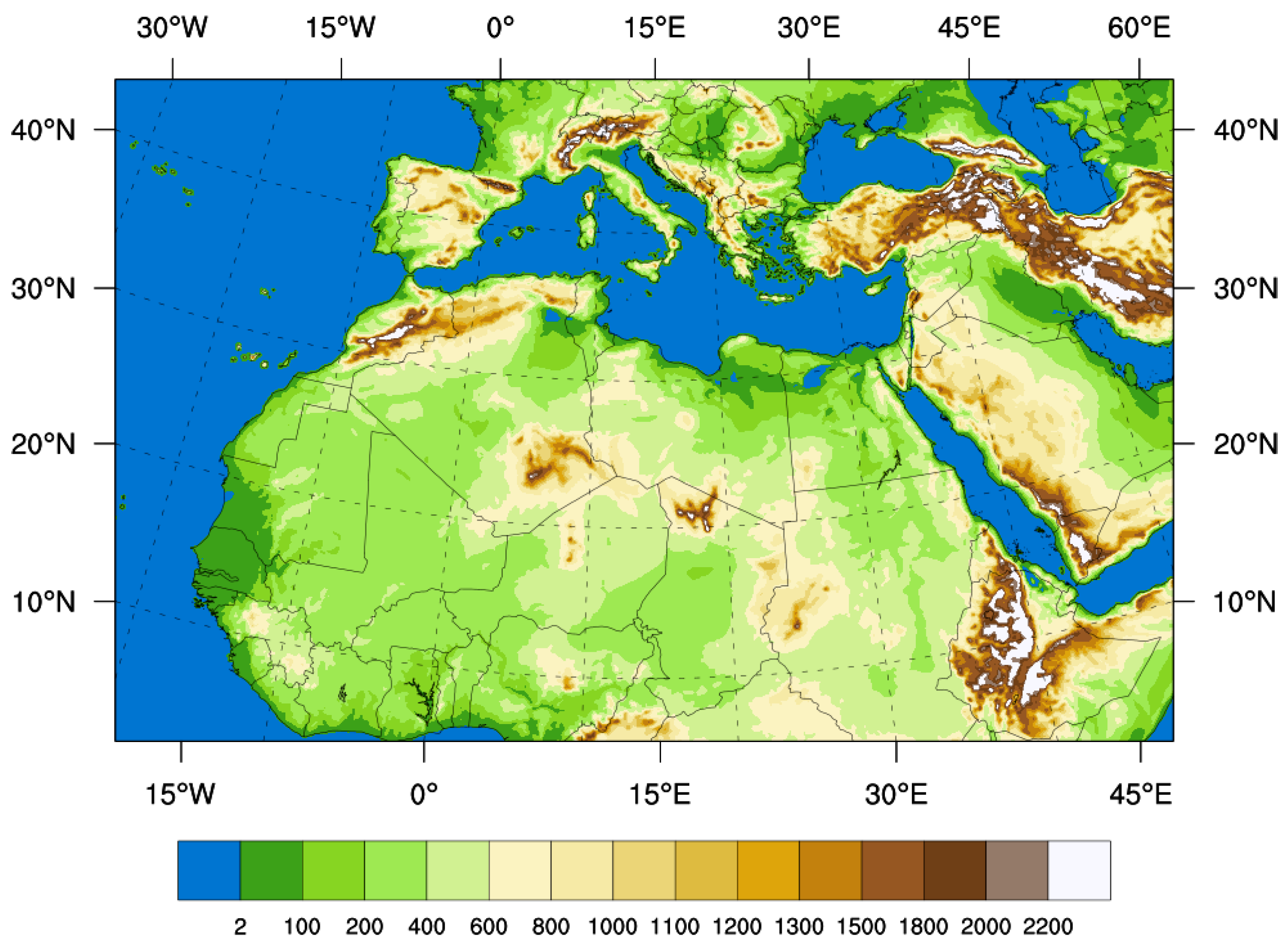
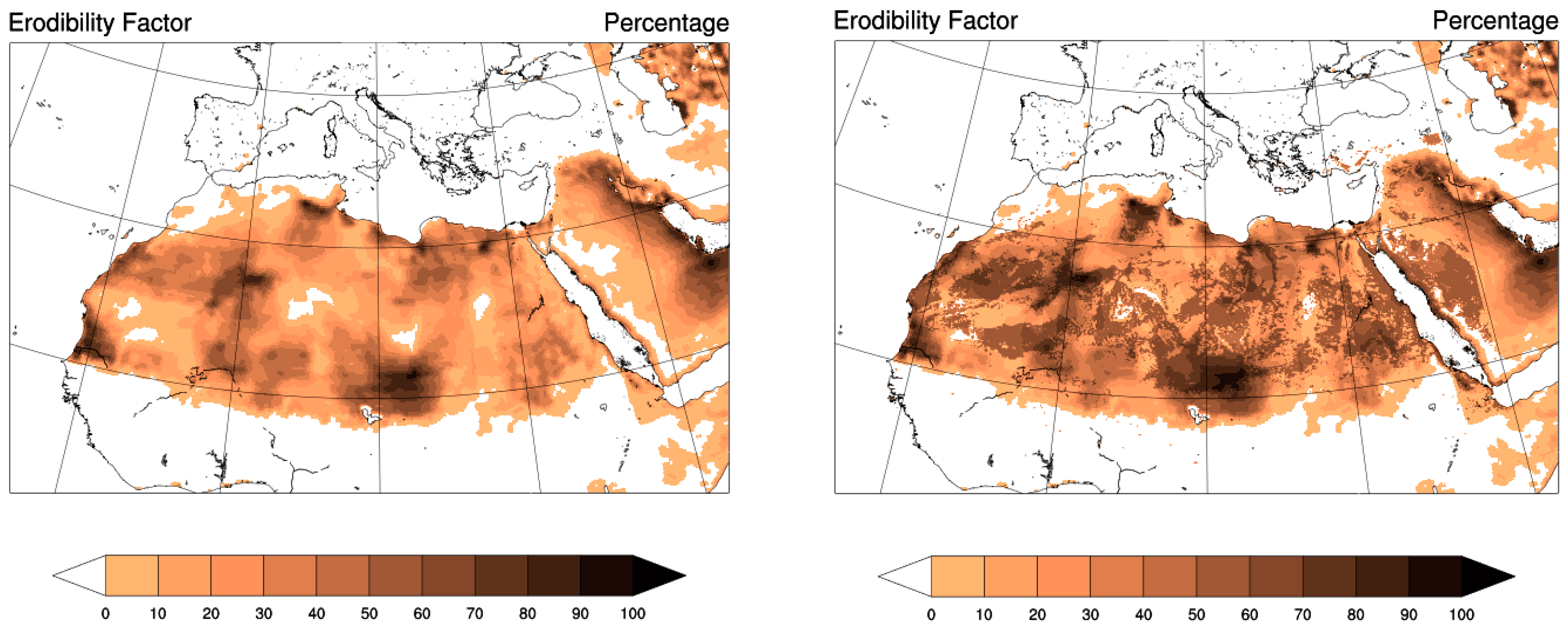
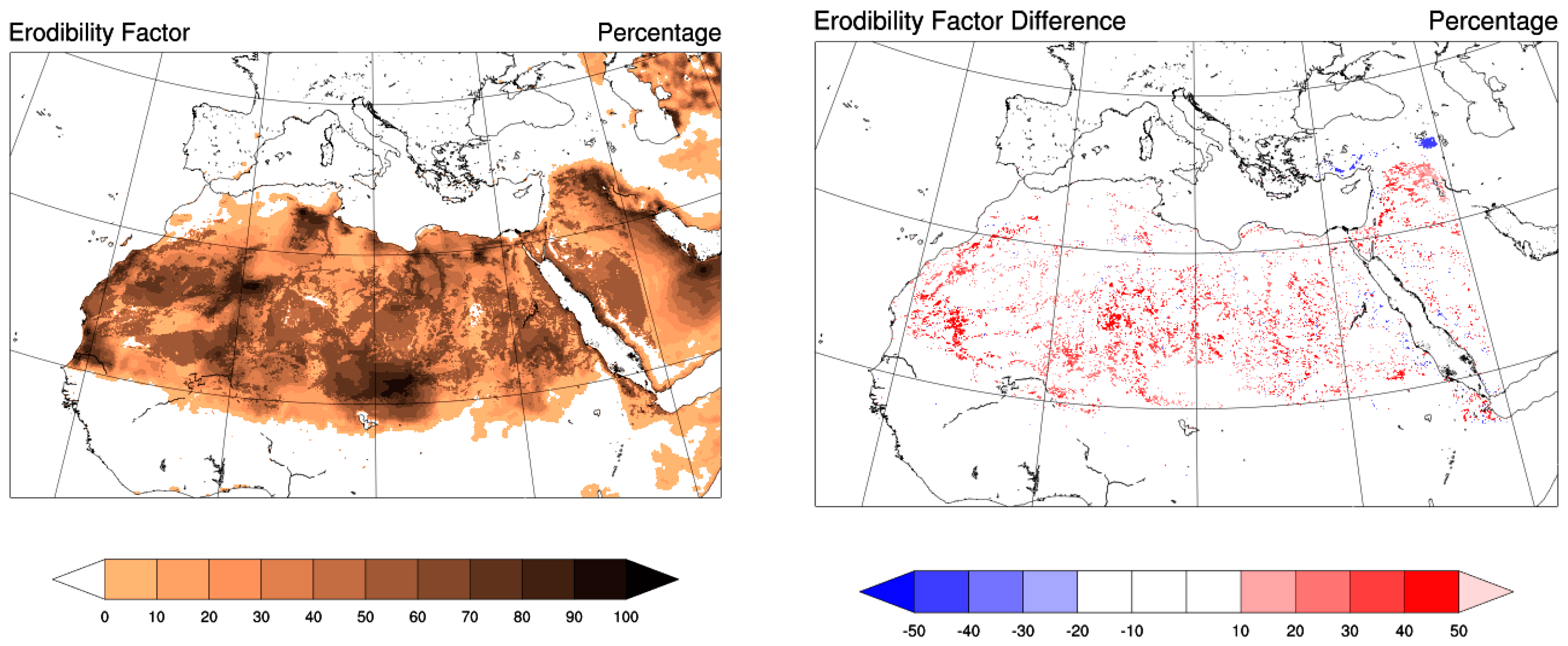

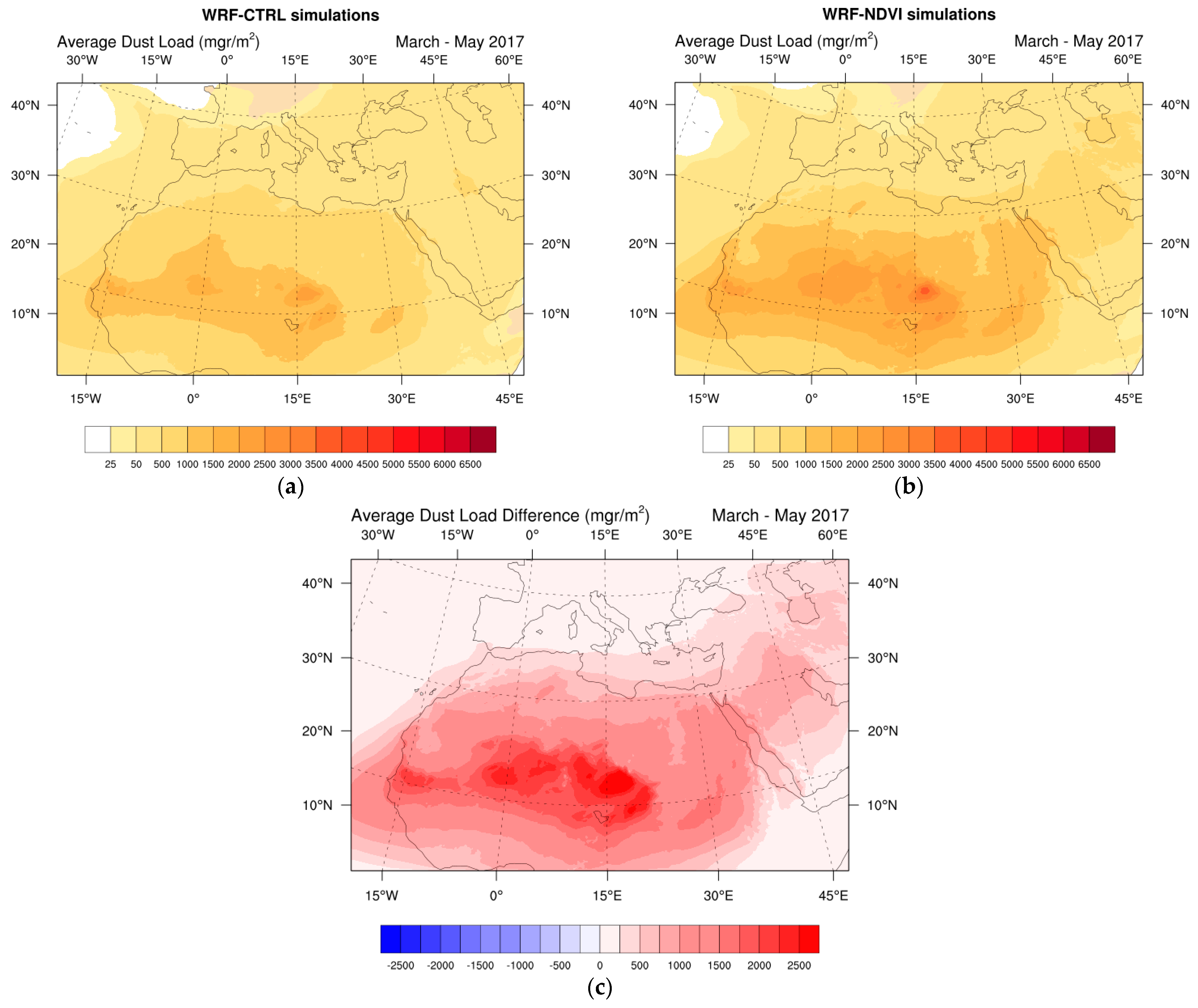
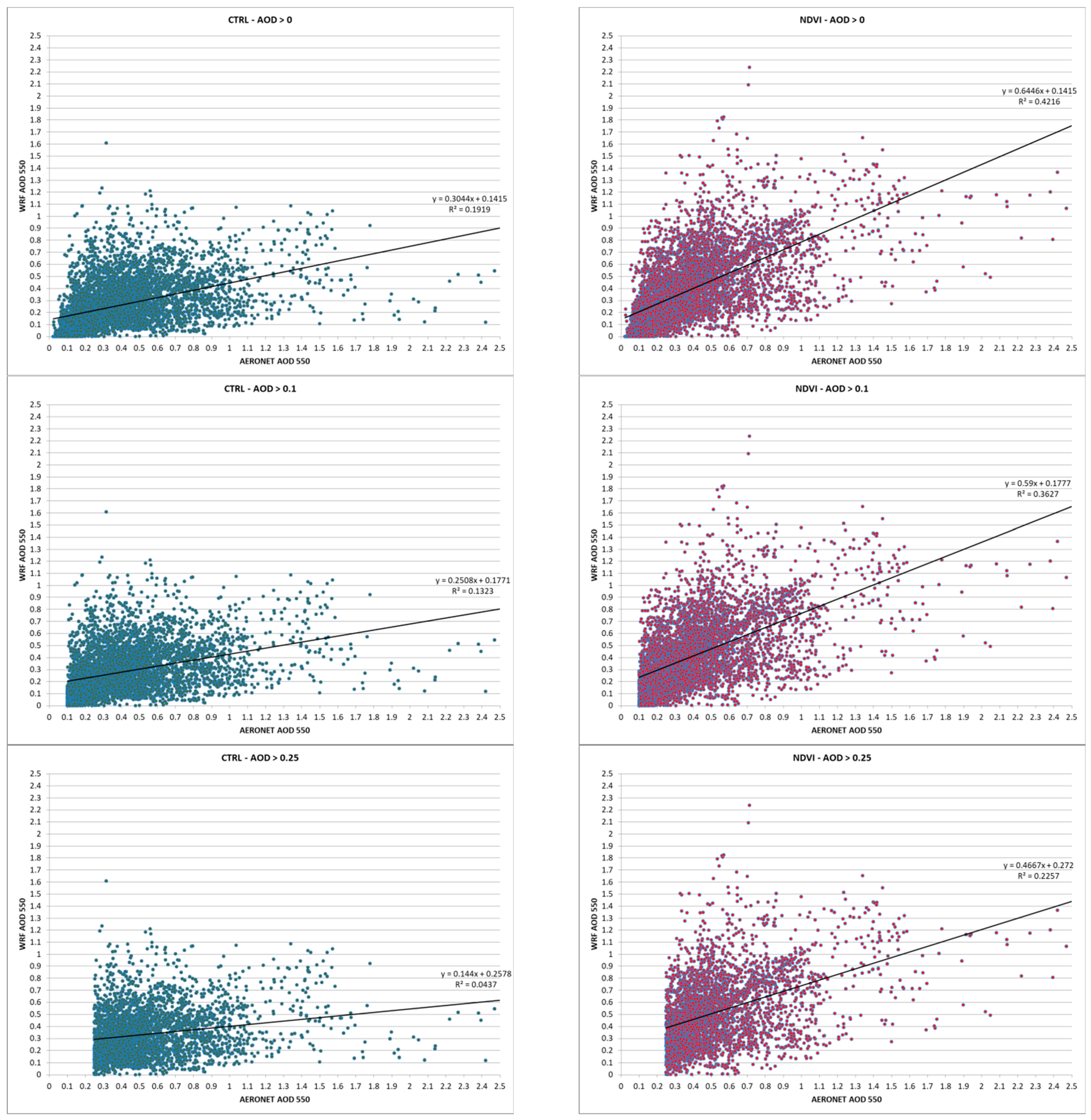
| Physical Parameter | Parameterization Scheme |
|---|---|
| Microphysics | Thompson scheme [48] |
| Cumulus Parameterization | Tiedtke scheme [49,50] |
| Shortwave Radiation | RRTMG [51] |
| Longwave Radiation | RRTMG [51] |
| Planetary Boundary layer | Mellor–Yamada–Janjic scheme [52,53] |
| Surface Layer Physics | Eta similarity [54] |
| Land Surface | Noah Land Surface Model [55] |
| Dust Scheme | GOCART [44] |
| Dust Production | AFWA scheme [45] |
| Simulation/ AOD Limit | BIAS | RMSE | CORR | FGE | MFB | # of Data Pairs |
|---|---|---|---|---|---|---|
| WRF-CTRL AOD > 0.0 | −0.12 | 0.30 | 0.44 | 0.68 | −0.48 | 8164 |
| WRF-NDVI AOD > 0.0 | 0.01 | 0.25 | 0.65 | 0.53 | −0.13 | |
| WRF-CTRL AOD > 0.1 | −0.13 | 0.32 | 0.36 | 0.61 | −0.41 | 7374 |
| WRF-NDVI AOD > 0.1 | 0.01 | 0.26 | 0.60 | 0.45 | −0.05 | |
| WRF-CTRL AOD > 0.25 | −0.20 | 0.38 | 0.21 | 0.62 | −0.49 | 4787 |
| WRF-NDVI AOD > 0.25 | −0.02 | 0.30 | 0.47 | 0.40 | −0.08 |
| Station/Simulation | BIAS | RMSE | CORR | FGE | MFB | # Data Pairs |
|---|---|---|---|---|---|---|
| ATHENS-NOA—Greece | ||||||
| NDVI | −0.05 | 0.14 | 0.40 | 0.43 | −0.23 | 65 |
| CTRL | −0.10 | 0.15 | 0.41 | 0.55 | −0.49 | 65 |
| AgiaMarina_Xyliatou—Cyprus | ||||||
| NDVI | −0.03 | 0.10 | 0.85 | 0.24 | −0.13 | 60 |
| CTRL | −0.10 | 0.12 | 0.89 | 0.34 | −0.34 | 60 |
| Aras_de_los_Olmos—Spain | ||||||
| NDVI | 0.02 | 0.09 | 0.65 | 0.57 | −0.05 | 47 |
| CTRL | −0.03 | 0.07 | 0.67 | 0.53 | −0.31 | 47 |
| Banizoumbou—Niger | ||||||
| NDVI | 0.09 | 0.24 | 0.51 | 0.33 | 0.17 | 245 |
| CTRL | −0.12 | 0.28 | 0.19 | 0.37 | −0.18 | 245 |
| Badajoz—Spain | ||||||
| NDVI | −0.02 | 0.16 | 0.22 | 0.37 | −0.14 | 64 |
| CTRL | −0.09 | 0.16 | 0.30 | 0.49 | −0.44 | 64 |
| Ben_Salem—Tunisia | ||||||
| NDVI | −0.06 | 0.15 | 0.74 | 0.44 | −0.28 | 116 |
| CTRL | −0.12 | 0.19 | 0.74 | 0.60 | −0.56 | 116 |
| Burjassot—Spain | ||||||
| NDVI | −0.04 | 0.13 | 0.76 | 0.68 | −0.51 | 24 |
| CTRL | −0.10 | 0.14 | 0.75 | 0.78 | −0.73 | 24 |
| Cabo_da_Roca—Portugal | ||||||
| NDVI | −0.03 | 0.10 | 0.83 | 0.73 | −0.57 | 94 |
| CTRL | −0.08 | 0.10 | 0.83 | 0.84 | −0.82 | 94 |
| Cairo_EMA_2—Egypt | ||||||
| NDVI | −0.02 | 0.22 | 0.49 | 0.35 | −0.13 | 255 |
| CTRL | −0.14 | 0.20 | 0.55 | 0.52 | −0.46 | 255 |
| Capo_Verde—Africa | ||||||
| NDVI | −0.15 | 0.30 | 0.68 | 0.53 | −0.36 | 231 |
| CTRL | −0.27 | 0.36 | 0.65 | 0.66 | −0.60 | 231 |
| CUT-TEPAK—Cyprus | ||||||
| NDVI | −0.07 | 0.22 | 0.10 | 0.57 | −0.33 | 121 |
| CTRL | −0.16 | 0.22 | 0.18 | 0.73 | −0.62 | 121 |
| Dakar—Senegal | ||||||
| NDVI | 0.07 | 0.35 | 0.45 | 0.42 | 0.12 | 685 |
| CTRL | −0.20 | 0.48 | −0.08 | 0.69 | −0.41 | 685 |
| Eforie—Romania | ||||||
| NDVI | −0.09 | 0.17 | 0.44 | 0.48 | −0.40 | 56 |
| CTRL | −0.14 | 0.19 | 0.45 | 0.63 | −0.62 | 56 |
| Eilat—Israel | ||||||
| NDVI | 0.05 | 0.20 | 0.67 | 0.41 | 0.11 | 309 |
| CTRL | −0.10 | 0.20 | 0.61 | 0.54 | −0.36 | 309 |
| El_Arenosillo—Spain | ||||||
| NDVI | 0.04 | 0.260 | 0.22 | 0.46 | −0.04 | 141 |
| CTRL | −0.05 | 0.22 | 0.26 | 0.53 | −0.33 | 141 |
| El_Farafra—Egypt | ||||||
| NDVI | 0.13 | 0.29 | 0.69 | 0.49 | 0.27 | 161 |
| CTRL | −0.06 | 0.22 | 0.72 | 0.39 | −0.09 | 161 |
| Evora—Portugal | ||||||
| NDVI | 0.00 | 0.13 | 0.20 | 0.41 | −0.10 | 115 |
| CTRL | −0.07 | 0.12 | 0.23 | 0.47 | −0.40 | 115 |
| Finokalia-FKL—Greece | ||||||
| NDVI | 0.03 | 0.15 | 0.79 | 0.33 | 0.01 | 111 |
| CTRL | −0.06 | 0.12 | 0.77 | 0.40 | −0.29 | 111 |
| Granada—Spain | ||||||
| NDVI | 0.01 | 0.13 | 0.59 | 0.34 | −0.03 | 143 |
| CTRL | −0.07 | 0.13 | 0.62 | 0.44 | −0.31 | 143 |
| IER_Cinzana—Mali | ||||||
| NDVI | 0.11 | 0.24 | 0.59 | 0.32 | 0.19 | 275 |
| CTRL | −0.10 | 0.30 | 0.07 | 0.49 | −0.24 | 275 |
| KAUST_Campus—Saudi Arabia | ||||||
| NDVI | −0.08 | 0.28 | 0.44 | 0.31 | −0.09 | 363 |
| CTRL | −0.27 | 0.39 | 0.40 | 0.69 | −0.67 | 363 |
| La_Laguna—Spain | ||||||
| NDVI | 0.16 | 0.35 | 0.30 | 0.77 | 0.08 | 145 |
| CTRL | 0.05 | 0.23 | 0.34 | 0.79 | −0.17 | 145 |
| Lecce_University—Italy | ||||||
| NDVI | −0.22 | 0.35 | 0.36 | 0.82 | −0.70 | 54 |
| CTRL | −0.28 | 0.38 | 0.36 | 0.94 | −0.91 | 54 |
| Medenine-IR—Tunisia | ||||||
| NDVI | −0.03 | 0.16 | 0.85 | 0.35 | −0.20 | 283 |
| CTRL | −0.12 | 0.19 | 0.87 | 0.51 | −0.490 | 283 |
| Pafos—Cyprus | ||||||
| NDVI | 0.00 | 0.24 | 0.11 | 0.66 | −0.25 | 60 |
| CTRL | −0.10 | 0.19 | 0.19 | 0.72 | −0.55 | 60 |
| Saada—Morocco | ||||||
| NDVI | −0.06 | 0.22 | 0.76 | 0.63 | −0.44 | 226 |
| CTRL | −0.14 | 0.23 | 0.77 | 0.77 | −0.68 | 226 |
| Santa_Cruz_Tenerife—Spain | ||||||
| NDVI | 0.06 | 0.27 | 0.48 | 0.82 | −0.30 | 261 |
| CTRL | −0.02 | 0.18 | 0.52 | 0.88 | −0.54 | 261 |
| SEDE_BOKER—Israel | ||||||
| NDVI | 0.05 | 0.20 | 0.57 | 0.39 | 0.07 | 324 |
| CTRL | −0.06 | 0.16 | 0.49 | 0.46 | −0.31 | 324 |
| Shagaya_Park—Kuwait | ||||||
| NDVI | −0.19 | 0.33 | 0.34 | 0.51 | −0.37 | 572 |
| CTRL | −0.32 | 0.42 | 0.24 | 0.78 | −0.75 | 572 |
| Tabernas_PSA-DLR—Spain | ||||||
| NDVI | 0.09 | 0.15 | 0.63 | 0.41 | 0.23 | 145 |
| CTRL | 0.01 | 0.09 | 0.68 | 0.33 | −0.05 | 145 |
| Tamanrasset_INM—Algeria | ||||||
| NDVI | 0.13 | 0.31 | 0.68 | 0.46 | 0.32 | 567 |
| CTRL | −0.09 | 0.28 | 0.63 | 0.43 | −0.25 | 567 |
| Technion_Haifa_IL—Israel | ||||||
| NDVI | −0.02 | 0.25 | 0.33 | 0.41 | −0.10 | 196 |
| CTRL | −0.13 | 0.26 | 0.27 | 0.56 | −0.44 | 196 |
| Weizmann_Institute—Israel | ||||||
| NDVI | −0.04 | 0.27 | 0.39 | 0.43 | −0.16 | 188 |
| CTRL | −0.16 | 0.27 | 0.34 | 0.59 | −0.54 | 188 |
| Zaragoza—Spain | ||||||
| NDVI | −0.07 | 0.12 | 0.44 | 0.90 | −0.78 | 31 |
| CTRL | −0.10 | 0.13 | 0.42 | 1.01 | −0.98 | 31 |
Publisher’s Note: MDPI stays neutral with regard to jurisdictional claims in published maps and institutional affiliations. |
© 2022 by the authors. Licensee MDPI, Basel, Switzerland. This article is an open access article distributed under the terms and conditions of the Creative Commons Attribution (CC BY) license (https://creativecommons.org/licenses/by/4.0/).
Share and Cite
Spyrou, C.; Solomos, S.; Bartsotas, N.S.; Douvis, K.C.; Nickovic, S. Development of a Dust Source Map for WRF-Chem Model Based on MODIS NDVI. Atmosphere 2022, 13, 868. https://doi.org/10.3390/atmos13060868
Spyrou C, Solomos S, Bartsotas NS, Douvis KC, Nickovic S. Development of a Dust Source Map for WRF-Chem Model Based on MODIS NDVI. Atmosphere. 2022; 13(6):868. https://doi.org/10.3390/atmos13060868
Chicago/Turabian StyleSpyrou, Christos, Stavros Solomos, Nikolaos S. Bartsotas, Kostas C. Douvis, and Slobodan Nickovic. 2022. "Development of a Dust Source Map for WRF-Chem Model Based on MODIS NDVI" Atmosphere 13, no. 6: 868. https://doi.org/10.3390/atmos13060868
APA StyleSpyrou, C., Solomos, S., Bartsotas, N. S., Douvis, K. C., & Nickovic, S. (2022). Development of a Dust Source Map for WRF-Chem Model Based on MODIS NDVI. Atmosphere, 13(6), 868. https://doi.org/10.3390/atmos13060868







